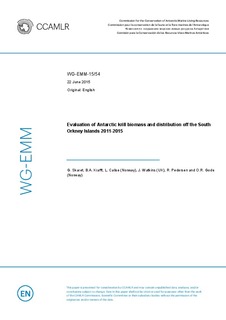Evaluation of Antarctic krill biomass and distribution off the South Orkney Islands 2011-2015
Research report
Permanent lenke
http://hdl.handle.net/11250/2398441Utgivelsesdato
2015-06-22Metadata
Vis full innførselSamlinger
Sammendrag
Annual acoustic trawl surveys for krill monitoring have been carried out by the Institute of
Marine research, Norway near the South Orkney Islands since 2011. The survey has been
conducted early in the fishing season (January/February), using two different krill fishing
vessels as platforms. The vessels were equipped with similar Simrad echo sounder systems
suitable for quantitative assessments, but the frequencies operated varied between vessels and
years. In addition, the survey coverage has varied between years in particular due to ice. In
order to allow for comparison of distribution and abundance of krill near the South Orkneys
among years, we here attempt to generate a coherent series of krill density estimates from the
5 years of surveys. We follow the CCAMLR protocol for biomass estimation as far as
practically possible, given that we work with unconventional sets of frequencies for target
strength estimation and target identification. In order to avoid variability due to differences in
coverage, we also define a stratum within the survey area on the north side of the islands with
full coverage in all years except 2013. The results show that except from the year 2015, krill
densities were high, in the range 100-300 g/m2
based on the 120 kHz recordings, and a total
estimated biomass of ca. 8 million tons of krill within the stratum in the peak year 2014.
There were also consistently higher values of acoustic backscatter on the north side of the
islands where the fisheries occur, than on the south side. Values were particularly high in the
north-west shelf area associated with underwater canyons. In 2012, and particularly in 2015,
low proportions of the acoustic backscatter were allocated to krill. The low proportions are
probably caused by shortcomings in the krill identification techniques when other pairs of
frequencies than combinations of 38, 120 and 200 kHz are used
Beskrivelse
-
